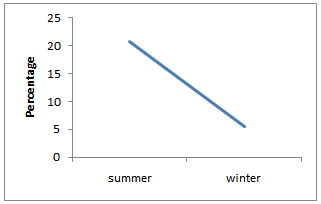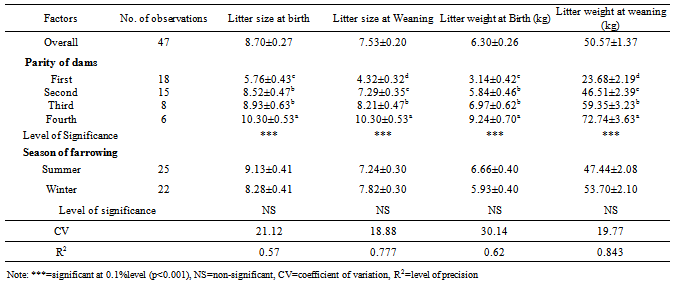-
Paper Information
- Next Paper
- Previous Paper
- Paper Submission
-
Journal Information
- About This Journal
- Editorial Board
- Current Issue
- Archive
- Author Guidelines
- Contact Us
International Journal of Agriculture and Forestry
p-ISSN: 2165-882X e-ISSN: 2165-8846
2013; 3(4): 141-144
doi:10.5923/j.ijaf.20130304.03
Effect of Non-Genetic Factors on Litter Traits of Hurrah Pigs in Nawalparasi, Nepal
B. B. Pokharel1, N. Bhattarai2, M. Sapkota3, P. Kafle4
1CTEVT/Jiri Technical School, Jiri, Dolakha
2Department of Animal Breeding and Biotechnology, IAAS, Rampur, Chitwan
3Department of Animal Nutrition and Fodder Production, IAAS, Rampur, Chitwan
4Animal Hospital Research and Training Center, Rupandehi
Correspondence to: B. B. Pokharel, CTEVT/Jiri Technical School, Jiri, Dolakha.
| Email: |  |
Copyright © 2012 Scientific & Academic Publishing. All Rights Reserved.
Data on litter traits of 47 Hurrah pigs of various VDCs of Nawalparasi district of Nepal over a period of July, 2011 to January 2012 constituted the material for the present study. The overall least squares means for litter size at birth (LSB), litter size at weaning (LSW), litter weight at birth (LWB) and litter weight at weaning (LWW) were 8.70±0.27, 7.53±0.20, 6.30±0.26 kg and 50.57±1.37 kg respectively. All the litter traits were found to be significantly influenced by parity of Dam (p<0.001). However, season was not found to be the important source of variation among litter traits. In general, litter traits showed increasing trend from 1st to 4th parity.
Keywords: Hurrah Pigs, Least Square Means, Litter Traits, Parity, Weaning
Cite this paper: B. B. Pokharel, N. Bhattarai, M. Sapkota, P. Kafle, Effect of Non-Genetic Factors on Litter Traits of Hurrah Pigs in Nawalparasi, Nepal, International Journal of Agriculture and Forestry, Vol. 3 No. 4, 2013, pp. 141-144. doi: 10.5923/j.ijaf.20130304.03.
Article Outline
1. Introduction
- The pigs are raised mainly for meat production and religious purposes in Nepal[1]. The estimated population of pig in Nepal during the year 2010/11 was 1.1 million with the distribution of 49.63% in Eastern region, 19.26% in Central region, 11.15% in Western region, 15.15% in Mid-western region and 4.82% in Far-Western region[2]. The population of pig which contributes 1.75% of the total livestock population has been increased by 147 thousand during the last five years (2005/06 to 2010/11) at the rate of 2.9% per year[2]. Pig meat shares 6.45% of the total meat production with 0.5% contribution in Agricultural Gross Domestic Product (AGDP)[2]. Pig meat is becoming popular and the production volume of pig meat was 17,923 metric tons in the year 2010/11[2]. However, demand of the pig meat has not been fulfilled from the domestic production. Profitability in pig enterprise primarily depend upon overall reproductive performance comprising age at first farrowing, farrowing interval, litter traits, sex ratio, and pre-weaning mortality[3]. These traits are important to reduce cost of rearing up to rearing age, reduce generation interval and increase genetic gain per unit time[4].There is little information about most of the characteristics regarding performance of indigenous Hurrah pigs. Most of them are yet to be standardized and are needed to be identified and conserved for future generations. They are raised in the tropical and subtropical regions of Nepal by certain ethnic groups such as Dom, Chamar, Harijan etc. and most of these groups are landless or have little land where they make temporary housings. Livelihood of these people is fully dependent on Hurrah pigs. They primarily sell Hurrah piglets and meat of adult pigs in different parts of the country including mid-hills. In spite of this, the population of Hurrah pigs is declining and they are in the need of conservation measures[5]. These indigenous pigs are grayish black in color with dropping barrel. The adult weight is 45 kg ranging from 40 to 55 kg. They are hardy with scavenging nature and are considered valuable because of their meat which resembles with the taste of wild pigs[5]. The purpose of this study is to characterize the local Hurrah pigs of Nawalparasi district based on their litter traits for improving production performance of these pigs in future.
2. Material and Methods
- Data pertaining to litter traits like litter size at birth (LSB), litter size at weaning (LSW), litter weight at birth (LWB) and litter weight at weaning (LWW) of 47 local Hurrah pigs of Nawalparasi district, Nepal were collected from the farmer’s field survey during the period July, 2011 to January 2012. A detail format was developed to make the data collection easier. The data were subjected to least squares analysis[6] to resolve the effect of non-genetic factors as well as to overcome the difficulty of disproportionate subclass numbers. The statistically significant means were compared using Duncan’s Multiple Range Test (DMRT). A fixed effect model given by[7] was used to analyze the litter traits of Hurrah pigs. The statistical model used in the present study is presented below:Yijk = µ + ai + bj+eijkWhere, Yijk = adjusted mean for litter size and litter weight at different stages of growth of Hurra pigs.µ = overall mean of the traitai = the effect of ith parity of the dams (i= 1,2, 3 & 4)bj = the effect of jth season of farrowing { j = 1(summer) and 2(winter)}eij = is the random element (residual effect) assumed to be normally and independently distributed.
3. Result and Discussion
- Least squares means and standard errors of various reproductive traits according to various subclasses are detailed in Table below. The overall least squares means and standard errors for litter size at birth (LSB), litter size at weaning (LSW), litter weight at birth (LWB) and litter weight at weaning (LWW) were 8.70±0.27, 7.53±0.20, 6.30±0.26 kg and 50.57±1.37 kg respectively. The overall means reported in this study for litter size at birth (LSB) and litter size at weaning (LSW) were little higher than the means recorded in Hurrah pigs[8]. The least square mean of litter weight at birth reported in this study was lower than Pakhribas Black pigs (9.32±0.25 kg) recorded by[9]. But litter weight at weaning was found to be similar with Pakhribas Black (50.6±1.45 kg) as recorded by[9].
3.1. Parity of Dams
- The parity of Dam significantly influenced all the litter traits (p<0.001). Least square means of liter size at birth varied from 5.76±0.43 to 11.61±0.71. First parity recorded lowest (5.76±0.43) LSB and fourth parity the highest (11.61±0.71) LSB. Similarly, litter size at weaning at first parity was lowest 4.32±0.32 while LSW at fourth parity was found to be highest (10.30±0.53). The means recorded for LSB and LSW were higher than the means reported by[8] in Hurrah pigs.[9],[10],[11] and[12] also reported similar trends in this trait due to parity of dams. Perusal of Table 1 revealed that parity first recorded lowest value of litter weight at birth (3.14±0.42 kg) and litter weight at weaning (23.68±2.19 kg) while fourth parity recorded highest value of litter weight at birth (9.24±0.70 kg) and litter weight at weaning (72.74±3.63 kg). Significant effect of parity of Dam on the litter weight at birth and weaning in this study was in line with the reports of[9] and[13] but was contrary to the reports of[14]. Lower values of litter size and birth belonging to first and second parity were possibly due to low rate of ovulation resulting from improper development of reproductive organs as described by[10].
 | Figure 1. Percentage showing pre-weaning mortality among piglets |
|
3.2. Season of Farrowing
- Season had non-significant effect on all the litter traits. Litter size at birth (LSB) during summer season (9.13±0.41) was found to be higher than LSB during winter season (8.28±0.41). On the other hand, litter size at weaning (LSW) during summer season (7.24±0.30) was found to be lower than LSW during winter season (7.82±0.30). Similarly,[9] and[10] also reported non-significant effect of season on litter size at birth and weaning. In contrary,[12] and[13] reported significant effect of season on the LSB and LSW in different genetic groups. Litter weight at birth (LWB) during summer season was found to be higher than LWB during winter season. On the other hand, litter weight at weaning (LWW) during summer season was found to be lower than LWW during winter season.[9],[10],[11] and[15] also reported non-significant influence of season of farrowing on the trait. However,[12],[13] and[14] reported significant effect of season of birth on litter weight at weaning. Non significant effect of season on the litter size at weaning may be due to the extra care taken to protect the animals from the extreme weather conditions that did not allow causing season effect on the trait as reported by[5]. During cold days, they were provided bedding materials, viz. empty feed bags and paddy straw for warmth. Piglets were protected from the extreme cold by providing high power electric bulb to keep them warm. During the hot days of summer season, animals were sprinkled with cold water.
3.3. Preweaning Mortality
- In summer, pre-weaning mortality was found to be 20.70% whereas in winter, pre-weaning mortality was found to be 5.55%. Heat stress among piglets and reduced feed intake by sows during summer months resulting to low milk production may be the result of higher pre-weaning mortality among piglets[16].
4. Conclusions
- The significant effect of parity on all litter traits (as reflected by present study) demands the use of parity as important criterion for selection to improve the overall reproductive performance of Hurrah pigs. Non-significant seasonal effect in many of the traits is obvious due to the human control over the adverse effects of different seasonal conditions. In fact, choosing the best sow with proper planning so as to breed it in the best time leads to significant improvement of the litter and other traits which can later be helpful not only in upgrading these valuable local pigs but also in the commercialization of pig industry as a whole. So, the findings of this study should be incorporated in the future projects comprising heritability estimates and correlation of different reproductive traits to increase genetic gain.
ACKNOWLEDGEMENTS
- We would like to thank Institute of Agriculture and Animal Science (IAAS) for providing technical support to conduct this research. Anirudra Chaudhary of Nawalparasi district and Badelal of Kapilbastu district are highly acknowledged for their help during data collection procedure. We thank Prof. Dr. Mohan Prasad Sharma, Department of Animal Breeding and Biotechnology, IAAS for his encouragement and inspiration during the course of study. We also thank Hurrah pig farmers of Nawalparasi district for their kind patience and invaluable cooperation during field study.
 Abstract
Abstract Reference
Reference Full-Text PDF
Full-Text PDF Full-text HTML
Full-text HTML